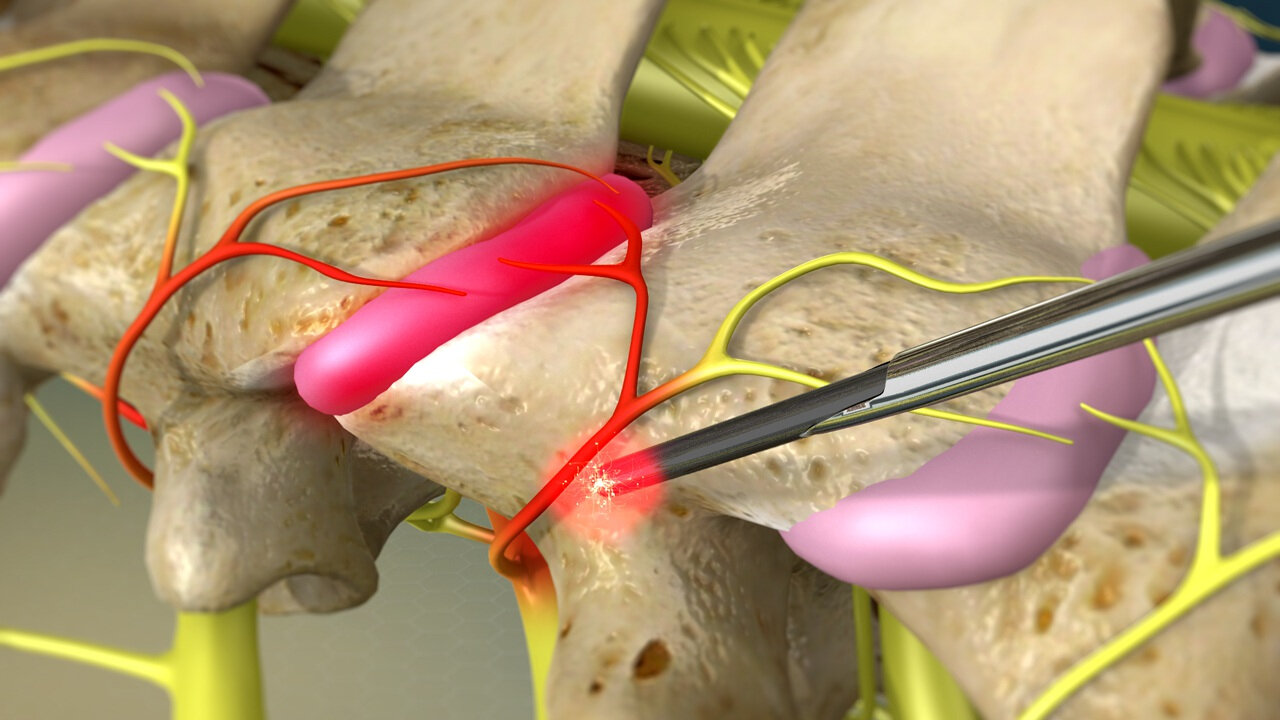Radiofrequency Ablation (Rhizotomy)
Radiofrequency ablation (RFA) is a safe, proven means of interrupting pain signals, such as those coming from irritated facet joints in the spine, genicular nerves in the knee, and femoral and obturator nerves in the hip. Radiofrequency current is used to heat up a small volume of nerve tissue, thereby interrupting pain signals from that specific area. Radiofrequency ablation is designed to provide long-lasting pain relief. This procedure is often used to sever nerve roots in the spinal cord. This process effectively relieves chronic back and neck pain and muscle spasms.
At Aptiva Health, we offer same-day and walk-in appointments for spine injuries and conditions to evaluate, diagnose, and make the appropriate referral for additional treatment based upon your specific spine injury or condition. We treat spine injuries and conditions in our Spine, Pain Management, General Medicine, Orthopedics, and Physical Therapy departments.
facet joints
The facet joints are small joints located at the back of the spine. There is a pair at each level of the spine (cervical, thoracic, and lumbar), which can undergo degenerative changes similar to knees, hips and shoulder joints. They are responsible for 30% of cases of back pain and the percentage increases with advancing age. Facet joint Osteoarthritis is similar to that which occurs in knees and hips. It involves damage to the cartilage, meniscal, ligaments and bone spur formation, which results in pain.
For spinal joint pain, a facet rhizotomy may provide lasting neck and back pain relief by disabling the sensory nerve at the facet joint. Facet joint rhizotomy is a minimally invasive procedure that is performed under local anesthetic and x-ray guidance. A needle is inserted into the back and directed onto the medial branch nerves that supply the joint. Local anesthetic is injected onto the nerve so that the person does not experience pain during the procedure. An electrode is inserted into the needle and an electric current is applied which heats the tissue around the needle and cauterizes the nerve creating damage that prevents the pain signal from getting to the spinal cord and brain. Facet joint rhizotomies have a 70 to 80 % success rate in reducing or eliminating back pain. This usually lasts for a year or more. The nerves can regenerate and pain can recur. If this happens the procedure can be repeated.
Preparation
Please arrange to have someone drive you home after the procedure, as you will not be able to drive or operate machinery for at least 24 hours after the procedure.
Do not eat or drink anything after midnight the night before the procedure, except for a small amount of water if needed to take medications on the day of the procedure.
If you have diabetes and use insulin, you must adjust the dosage of insulin the day of the procedure. Consult the doctor who manages your insulin or diabetes medication for any necessary adjustments. Bring your diabetes medication with you so you can take it after the procedure.
If you take any blood-thinning medications or antiplatelet medications, these must be stopped with the permission of your doctor who manages these medications.
Continue to take all other medications with a small sip of water. Bring all medications with you so you can take them after the procedure. It is important to note that you must not stop taking any medication without first consulting with your primary or referring doctor.
Procedure
RFA is a minimally invasive procedure that does not require anesthesia. During the procedure, you will lie on your stomach, or for some neck procedures, on your side.
Your pain management doctor will numb a small area of skin around your spine with an anesthetic. The doctor will then use X-ray guidance to direct a special radiofrequency needle alongside the targeted nerves. To confirm proper position, a small amount of electrical current is passed through a probe placed in the needle to the targeted nerve. At this point, you may experience brief pain or a muscle twitch.
Once proper position is confirmed, more local anesthetic is given to the area where the RFA will be performed. During the procedure, most patients feel either nothing or a mild warm sensation.
The procedure may take up to one hour, depending on the treatment site and number of treatments performed.
Recovery
After the procedure, you may experience soreness in the targeted area for a few days. Rare complications include infection, bleeding and nerve damage. Although results vary from patient to patient, the effectiveness of RFA may last from three to 12 months. Often the nerve will eventually regenerate and in some cases, the joint pain may return. We encourage all patients to regularly consult with our Pain Management department to keep them updated if symptoms worsen or return.
In a recent study, lumbar medial branch RFA was shown to be an effective, durable treatment for a significant proportion of patients with recalcitrant lumbar z-joint pain when candidacy is determined by the guideline-concordant paradigm of ≥80% pain relief with dual comparative MBBs.





